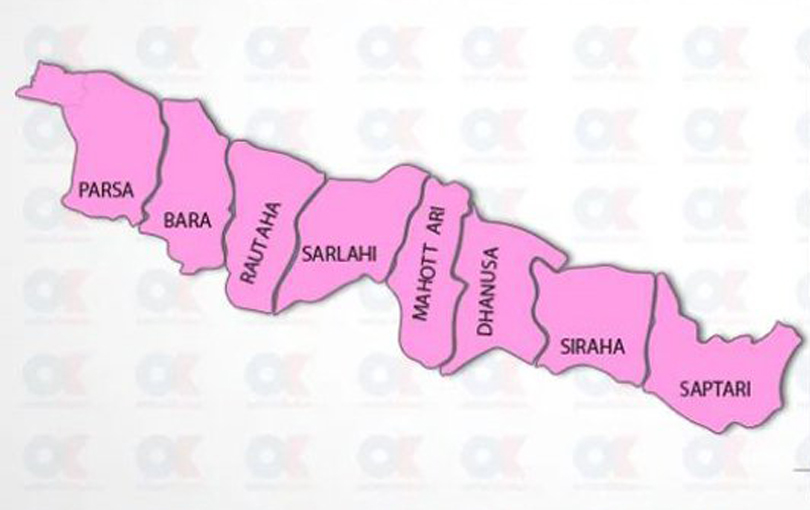In October 2023, when 51-year-old Ram Bujhaun Yadav of Musaharnia Rural Municipality-5, Mukhiyapatti, Dhanusha, was at a relative’s house, someone told him that two Indian Sashastra Seema Bal (SSB) personnel were looking for him.
Anxious, he rushed home wondering why they were looking for him.
“They asked me if the paddy field in the no man’s land was mine. I told them yes and they asked me to cut down the paddy immediately,” he said.
The paddy was not ripe and Yadav asked them for some time. However, the SSB personnel told him he had to cut down his paddy immediately.
Ram Bujhaun and his wife Tetari Devi each own a 677-square-metre plot of land. As Nepal and India reevaluated the border, Ram Bujhan’s land was been deemed to be near the no man’s land as it now has two demarcation pillars.
Frustrated, Ram Bujhaun cut the paddy before it was due to be harvested. Now, he has been asked to not plant anything on the land as it falls in the no man’s land.
“Our border police don’t say a word. I can’t fight the SSB on my own,” says Ram Bujhaun adding he had decided not to plan anything on the land anymore.
Woes of the farmers
When the Jamuna River, which flows through the no man’s land between Nepal and India, changed its course some two decades ago, some border pillars went missing.
In 2018, with the then Chief District Officer of Dhanusha, Pradeep Raj Kandel, and an official from Madhubani district, Bihar, India, a team that included border security forces from both countries, the Armed Police Force of Nepal, and SSB of India began placing border pillars after land measurement by technicians.
Locals have raised concerns, stating that border pillars have been positioned, encroaching approximately 50 to 100 meters of land into Nepal compared to the previous position. Many like Ram Bujhaun are unaware of when these border pillars were placed.
“I did not know that pillar was placed here. After I found out when I asked the village leaders, many said they were placing the border pillars as they pleased,” said Ram Bujhaun.
He was told to carry on planting paddy and that it would not matter as these issues had happened in the past.
“They encroached on my land and have asked me not to plant anything. This is gross injustice,” he says.
Ram Bujhaun’s family owns a total of 4,000 square metres of land, with 2,000 square metres belonging to him and the remaining 2,000 square metres to his brother Bechan. However, 1,000 square metres of his land is now located on the Indian side after the demarcation. Despite this, he has been farming on the land and continues to pay taxes to the Department of Land Management and Archive in Nepal.
“They have marked my land to be on the Indian side and placed border pillars on it. I’ve been farming till now but I don’t know when they will ask me to stop,” he says.
Ignorance of the government

The former ward chair of Mukhiyapatti Musharniya Rural Municipality-5, Ram Naresh Yadav, said that over time, India has encroached on numerous Nepali lands in various locations in the Madhesh Province. This, he says, happened due to the Nepali administration’s ignorance and weak stature.
“They (Nepali administration) were careless and that meant the Indian side placed these border pillars by encroaching on Nepali land,” says Ram Naresh.
He said that over 40 farmers from wards 1, 5, and 6 have land ranging from 300 to 1,600 square metres on the Indian side.
“These farmers have land ownership certificates, but they cannot farm as the SSB says the land is in India and not Nepal,” said Ram Naresh.
In 1996, land ownership certificates were distributed after surveying the land in the border area. Local Dharmendra Kumar Yadav said that since then, the locals have been paying their land tax regularly. In 2018, when the pillar was being placed, the locals protested when they saw their land was being encroached on. However, since the demarcation had been agreed upon by high-ranking government officials of Nepal and India, the farmer’s voices went unheard.
“We tried to stop when the border pillars were being placed on our land. But the administrators from both sides forcibly put it there without even trying to hold a discussion,” said Harish Chandra Yadav.
The Chief District Officer of Dhanusha, Chakrapani Pandey, says that the border pillars were placed by the technical team after the measurements and with the agreement of the high-ranking officials of the two countries.
“The fields and houses that are built in no man’s land have recently been cleared. No one can do anything in this particular area,” said Pandey. “We understand the people’s concern but we cannot do anything about it now.”
The post Erroneous border pillar placement plagues Nepali farmers in Madhesh appeared first on OnlineKhabar English News.
Comments
Post a Comment